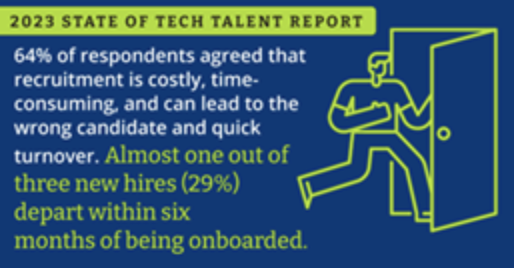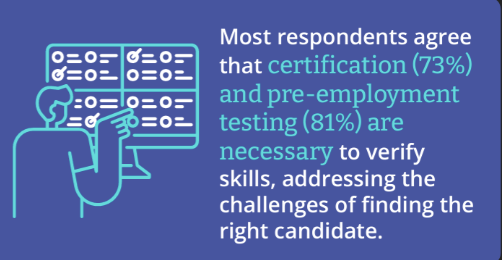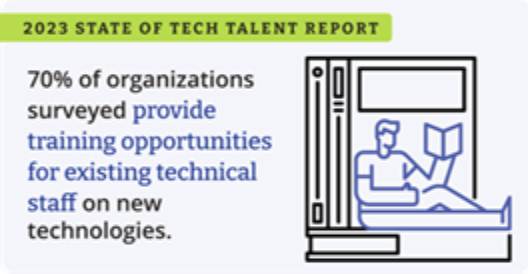
Despite economic headwinds, the demand for technology professionals remains strong.
by Clyde Seepersad
July 26, 2023
After the fast and furious hiring trends of the last three years, 2023 has become a turning point for IT hiring at many companies. Anxiety about the economy has added complexities, rather than clarity. As highlighted in our “2023 State of Tech Talent Report,” which gathered responses from more than 400 IT hiring managers and staffing professionals, more than 50 percent of organizations surveyed have revised their hiring plans due to economic uncertainty. But, despite external headwinds, demand for technology professionals remains strong, according to the report.
Continued demand for technical staff is driven by emerging technologies such as artificial intelligence and machine learning, for which 46 percent of organizations indicated they intended to continue hiring this year. Organizations are also increasing headcount in 2023 for other existing, but always evolving technologies. For example, 50 percent said they would hire more staff for cloud and cyber security.
Upskilling is an attractive option to external hiring

Despite increasing demand for technical talent — and an available pool of jobseekers from recent tech firm layoffs — challenges in talent acquisition remain. Sixty-four percent of respondents agree hiring is a time-consuming and costly process, and often does not lead to the right candidate for the position.
Respondents pointed toward upskilling as a potential solution to cope with a tricky situation. Fifty-five percent agreed upskilling can help fill a new position, and while it does open up other positions to be backfilled, finding junior technical staff is often easier than senior ones. Growing team skills through upskilling junior team members can also be a prudent way of managing costs.
Upskilling reduces risks of another challenge that respondents highlighted: onboarding. Sixty-four percent view onboarding as a time-consuming activity that takes valuable internal resources away from other critical projects. Nearly 80 percent agree hiring the wrong candidate and having to onboard again is an issue. Adding to the challenge, respondents say recently recruited employees depart at a high rate of 29 percent, or nearly one out of three new recruits, within six months of being onboard, whether voluntary or involuntary, costing organizations lost time and resources.

Upskilling existing talent helps teams in three key ways compared to external hires. First, it enables both the organization and teams to develop specific technical skills to meet specific needs.
Second, it helps ensure a cultural fit, since the team member is already familiar with stakeholders and the organization, often resulting in increased retention.
Finally, upskilling internal candidates addresses another concern of hiring external candidates, where 81 percent said pre-employment testing and 73 percent said certification were necessary to verify the candidate had the requisite skills. Upskilling is already validated and leveraged by some organizations in a variety of ways. Ninety-one percent of organizations believe upskilling to expand or improve IT staff technical skills are either extremely important or very important. Thirty-nine percent of organizations view upskilling as effective at training for complex roles.

The value of upskilling is also underscored by the fact that 70 percent of organizations already provide training opportunities for new technologies to current staff, according to the report. Forty-one percent respondents highlighted the need for additional training as the technical organization scales.
Relationship between team numbers and workload don’t always correlate
Respondents indicated hiring more people doesn’t always solve conventional woes, which include increased timeframes for product delivery when there is a technical staff shortage. While 43 percent of organizations that plan to reduce staff expect longer time frames for product delivery, only 25 percent of those planning to increase staffing believe this action will result in a quicker product delivery. This is a clear indication that more resources don’t always deliver faster time to market.
Organizations risk seeing turnover rise as workloads could increase with more organization demands and reduced headcount. Thirty-nine percent of organizations that intend to reduce staff and 30 percent of those that are freezing new hires expect workloads of technical staff members to increase. A minority, only 26 percent of those increasing staffing, believe it will reduce the workload of their technical staff members.
As organizations go through reorganization, restructuring and budget fluctuations, one thing is clear from this survey of decision makers. Teams looking to maintain product delivery timeframes for their organizations must consider training and certification as a supplement to hiring. A single strategy of buying talent by ramping up the recruiter button will never get you where you need to be. It’s crucial to consider talent in non-traditional places, and that starts with identifying potential talent within the internal organization.



